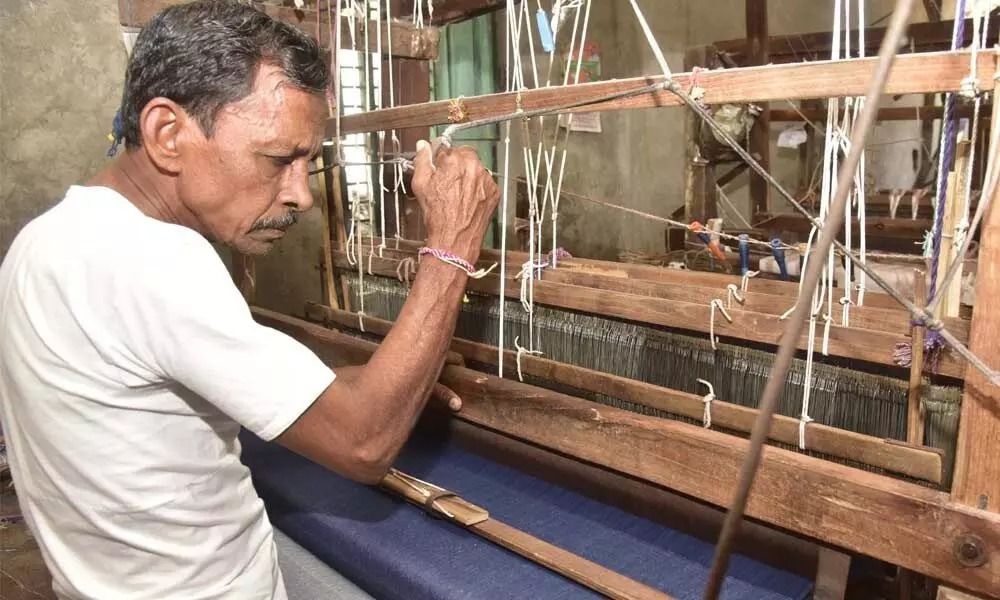
చేనేత భారతీయ సంప్రదాయానికి పునాది. ప్రాచీన వారసత్వానికి ప్రతిరూపంగా నిలిచిన ఈ రంగం నేడు ఆధునికత పేరిట క్షీణిస్తున్న వేళ, ప్రభుత్వం చురుకైన విధానాలు తీసుకుంటేనే నేతన్నలకు జీవనాధారం లభించగలదు.
భారతదేశం చేనేత వారసత్వానికి అద్భుత నిదర్శనం. చేతివృత్తులలో అగ్రగామిగా నిలిచిన చేనేత రంగం, వ్యవసాయానంతరం దేశంలో రెండవ అతి పెద్ద ఉపాధి ప్రదాతగా కొనసాగుతోంది. ఇందులో 70 శాతం పైగా మహిళలే కార్మికులుగా పని చేస్తున్నారు. అయితే కాలానుగుణంగా ప్రభుత్వాల నిర్లక్ష్యంతో ఈ రంగం క్షీణిస్తున్నది. దీన్ని కథల్లో, నవలల్లో, సినిమాల్లో పలువురు రచయితలు, దర్శకులు చర్చనీయాంశం చేశారు.
పోరంకి దక్షిణామూర్తి ‘ముత్యాల పందిరి’ నవలలో, ‘మల్లేశం’ సినిమాలో చేనేత జీవితం ఎలా ఉందో స్పష్టంగా చూపారు. సామెతలు, పద్యాలు, పాటలు నేతన్నల బాధల ప్రతిబింబంగా మారాయి. అనేక మగ్గాలు మానుకోగా, మరమగ్గాలు, ఇప్పుడు ఆధునిక మగ్గాలు వాటిని గ్రసిస్తున్నాయి. ఫలితంగా నేతన్నల జీవితం అగమ్యగోచరంగా మారింది. గోరటి వెంకన్న పద్యాల్లో చూపినట్టే, గ్రామ స్వరాజ్య భావన కాలబాగోతంలో కలిసిపోతున్నది.
ప్రతి సంవత్సరం ఆగస్టు 7న ‘జాతీయ చేనేత దినోత్సవం’ నిర్వహిస్తారు. ఇది 1905లో కలకత్తాలో ప్రారంభమైన స్వదేశీ ఉద్యమానికి గుర్తుగా జరుపుతున్నారు. ‘చేనేతకు మద్దతు ఇవ్వండి, మన సంప్రదాయాన్ని కాపాడండి’ అనే థీమ్తో ఈ దినోత్సవాన్ని గతేడాది జరిపారు. సంత్కబీర్ అవార్డులు వంటి గుర్తింపు మేలు చేస్తాయి కానీ, సమస్యల పరిష్కారమే ప్రధానమే కావాలి.
చేనేత రంగంలో గుత్తాధిపత్యాన్ని తొలగించకుండా, ప్రాథమిక ముడిసరుకు నుంచి విక్రయ దశ వరకు సమర్థవంతమైన వ్యవస్థ లేకుండా, రంగానికి మనుగడ కష్టమే. ప్రభుత్వం నూలు రాయితీ, మార్కెటింగ్ సదుపాయాలు కల్పిస్తే మాత్రమే ఈ రంగం బలోపేతం అవుతుంది. బనారసి పట్టు, పష్మినా శాలువాల నుండి తెలంగాణ గద్వాల్ చీరల వరకు వివిధ రాష్ట్రాల సంప్రదాయ నైపుణ్యాన్ని కాపాడేందుకు చిత్తశుద్ధి అవసరం.
Handloom is one of India’s most vibrant and ancient traditions. It stands as a testimony to the skill of our artisans and is the second-largest employment provider after agriculture. More than 70% of those working in this sector are women. However, over time, due to continued government apathy, the sector is gradually declining. This decline has been reflected and explored in various literary works, novels, and films.
Author Poranki Dakshinamurthy portrayed this reality in his novel Mutyala Pandiri, and the film Mallesham also powerfully showcases the everyday struggles of weavers. Proverbs, poetry, and songs have become a voice for the woes of the weaving community. While traditional looms are fading away, they are now being replaced by modern power looms, worsening the livelihood of handloom workers. As poet Goreti Venkanna expressed in his verses, the dream of rural self-sufficiency is slowly vanishing.
Every year, August 7 is celebrated as National Handloom Day in India to commemorate the Swadeshi Movement that began in Kolkata in 1905. In 2024, the theme was “Support Handloom, Preserve Our Tradition.” While awards like the Sant Kabir Awards give recognition, what the sector truly needs is concrete problem-solving.
Without eliminating middlemen, and without a robust system from raw material procurement to marketing, this sector cannot survive. If the government provides subsidies on yarn and ensures proper marketing infrastructure, the sector can be revitalized. From Banarasi silk to Pashmina shawls, and from Gadwal sarees of Telangana to various regional weaves, sincere efforts are needed to protect this cultural heritage.